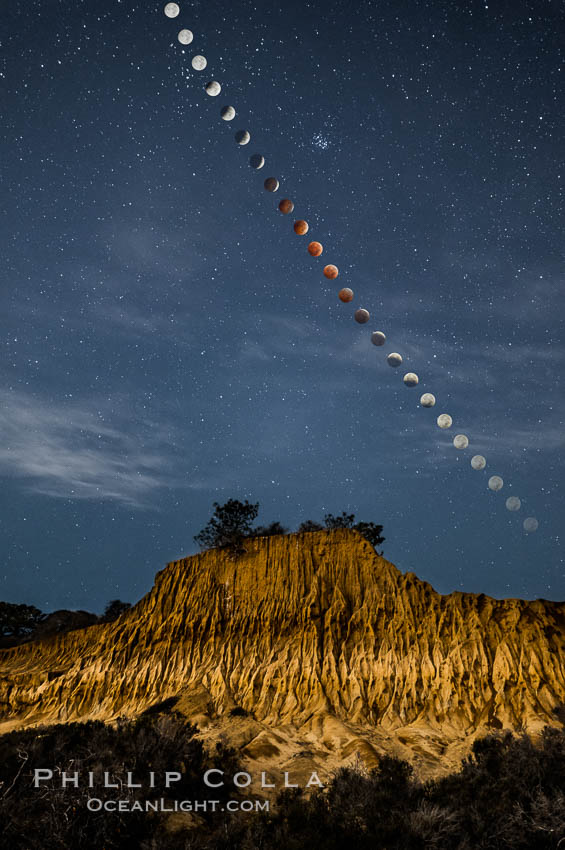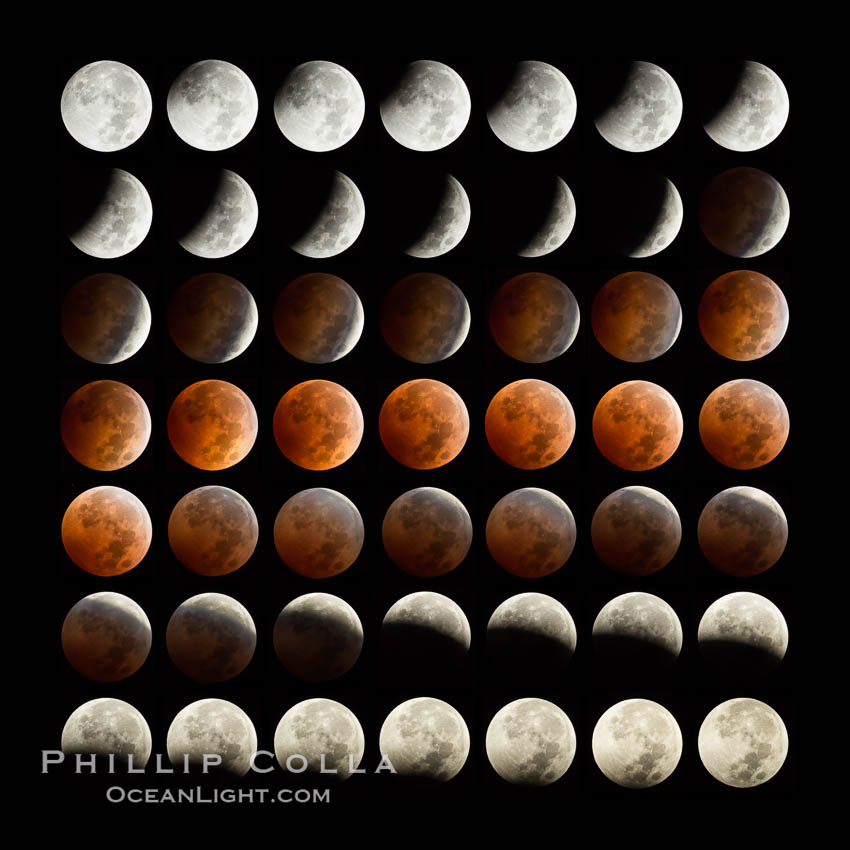Lunar Eclipse Sequence Over Broken Hill, Torrey Pines State Reserve. While the moon lies in the full shadow of the earth (umbra) it receives only faint, red-tinged light refracted through the Earth’s atmosphere. As the moon passes into the penumbra it receives increasing amounts of direct sunlight, eventually leaving the shadow of the Earth altogether. October 8, 2014.
Image ID: 29412
Location: Torrey Pines State Reserve, San Diego, California, USA
I have made a few photographic sequences of lunar eclipses, including several of the total lunar eclipse of April 15 2014 (version 2, version 3). I wanted to do something similar for the October 8 2014 lunar eclipse, but did not have the freedom to go photograph out in the desert where the air was likely to be clear. On the evening of the eclipse conditions were iffy, and down on the beach the air was heavy and wet so the pier was out — it was on the verge of turning to fog. Up on the mesas above and inland from the beach the air was much clearer and drier but still the shooting looked iffy, I was not sure the eclipse would even be visible. As it turned out I was able to get the images for which I was hoping, although things were not as clear as I probably would have found in the desert.
My planning for the eclipse was something like this: the penumbral phase of eclipse was to begin at 2:15am at 227 degrees on the compass and inclination of 53 degrees. Full eclipse would begin at 3:25 (245 degrees, 41 degree inclination) and end at 4:24am (256 degrees, 30 degree inclination). The penumbral phase would end at 5:34 (266 degrees, 16 degree inclination). This meant the “rectangle” that the path of the eclipse would take through the sky was roughly 40 degrees horizontally (left to right on the compass) and spanned a vertical inclination of about 37 degrees. I figured a lens with about 24mm of focal length, or a little more, held in portrait orientation — which covers approximately 73 degrees vertically and 53 degrees horizontally would work well, since it would allow for some foreground and would cover the entire left-right travel of the moon with room to spare on all sides. Mind you this may sound like some sort of complicated math but in truth a few minutes with The Photographer’s Ephemeris and a few notes on the back of a VISA envelope were all that was required to set up the plan for that night. The “center” of the eclipse would be at a compass angle of about 250 degrees, so I setup my camera in that direction, configured it to shoot periodic bracketed images all night long using an intervalometer, and crossed my fingers the sky would remain clear for the two and a quarter hours that the eclipse would happening.
I also shot individual images of the eclipsing moon with 560mm of focal length — the Canon 200-400 f/4 lens with built-in 1.4x teleconverter turned out to be perfect for this, and I periodically used live focus to ensure the moon was as sharp as possible. That lens, coupled with good focus and a good sensor, can really resolve a lot. I composited these sharp and detailed moon images onto the best single image of the “background” in the location and orientation in which the moon travelled across the sky. They appear about twice as large as the moon actually appeared in the original wide-angle photographs. I was a little surprised to find the path was slightly convex (relative to the ground) as in my previous south-facing sequences the path was strongly concave, but then realized after looking at the star trails of the images from that night that indeed this was the proper path of the stars and moon. I was facing only about 20 degree south of west and Polaris was about 110 degrees to the right. All heavenly objects have an apparent rotation about that one star, leading to the path of the moon you see here. The following image is a huge (12000 x 12000) mosaic of the sequence, with some impressive detail in the moon including some visible lunar mountains when the sun was just skimming the edge of the moon in some of the frames. The frames I found the most interesting, and challenging to expose, are those were there is still direct sunlight case upon the moon while at the same time some of the “blood red moon” coloration is beginning to appear in the shadowed area of the moon. The moon is yellower at the end of the sequence than it is at the beginning — at the beginning it is high in the sky and the optical path passed through relatively little atmosphere, but toward the end of the sequence the moon was nearly setting and the optical path passed through much more atmosphere, affecting the “color temperature” of the moon and rendering it with a yellowish hue. (Hue: does anyone actually use that word in conversation?)
Lunar eclipse sequence. While the moon lies in the full shadow of the earth (umbra) it receives only faint, red-tinged light refracted through the Earth’s atmosphere. As the moon passes into the penumbra it receives increasing amounts of direct sunlight, eventually leaving the shadow of the Earth altogether. October 8, 2014.
Image ID: 29411
Cheers, and thanks for looking!





